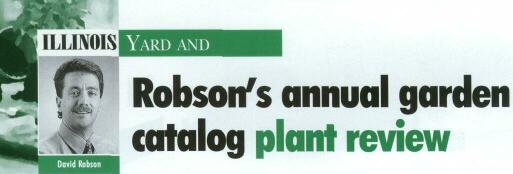 |
Home | Search | Browse | About IPO | Staff | Links |
 |
Home | Search | Browse | About IPO | Staff | Links |
|

Garden catalogs are the dream machines of the winter months. You can spend hours dreaming of having beautiful flowers the same colors and quality as in the catalogs. And that's about the only time that they really do come true. Each year, free seed from the All America Selections organization lands on my desk. These are the plants that are supposed to be the tops for the upcoming year. I can't say how many years I've been growing the plants and making comments on their worthiness. And trust me, not all have been worthy of inclusion in the garden. I'm still shaking my head after 10 years trying to figure out the Thumbelina carrot, and why anyone would plant something that grows no larger than 2 inches. That brings me to this year's winners. Some are worthy of trying. Some, if you trust me, are not. The most interesting plant and a rare gold medal winner is Purple Majesty millet, which is a relative of corn, and mainly grown by farmers, not that there is anything wrong with that. First, the plant likes full sun, warmth, lots of water and lots of fertilizer. It can grow to 4 feet. Leaves are a dark purple, and plants branch easily, producing dense flower heads. The yellow pollen of the flower heads is quickly replaced by purple seeds, which the birds supposedly like. When frost came, the plant bit the dust, and so did the seed heads, which means the birds will have to rely on my neighbor's feeder. It's a plant I might just grow again. Which is not the case with the Eustoma Forever White. Eustomas go by the common name of Lisianthus, which is arguably not that much better of a name. These are plants that like hot, dry conditions, but take about six months from the time you plant the seeds until they flower. In other words, you have to start the plants after you're done reading this column in order for them to bloom by July. There are new Eustoma about every year, and none have really piqued my interest. Queen Elizabeth II was recognized this year with a plant called Agastache Golden Jubilee. The foliage of the plants is a yellow-green almost like chartreuse, which might make you think the plant is anemic, yet it isn't. Somewhere in late July, it started producing blue flowers tinged with some purple. They are classified as an herb used in teas, and somewhat hardy, which means it might survive if the temperatures don't drop too low or too fast. Vincas are the summer stalwarts, thriving in the heat of the day. Jaio Dark Red did as well as most vincas, meaning that it is worthy of trying. The color is an interesting shade of red unlike most supposedly reds of the vincas. Consistency was not the hallmark of two annual flowers: Gaillardia Sundance Color and Prairie Sun Rudbeckia. While the two flowers held up under the sun, and the Gaillardia or Indian Blanket flower had an unusual color spectrum from the dark burgundy to yellows, the plants seemed more content to sit there at times than perform. Prairie Sun Black-eyed Susan, when it bloomed like it was supposed to, was great with green center. Unfortunately, it seemed every other flower was the typical black-eyed Susan and nothing to write home about, not that I write home much anyway. Petunia Blue Wave continues the Wave series with blue flowers. It's perfect for hot weather and hanging baskets. I coupled mine with Petunia Merlin Blue Morn which had a similar blue along the edges of a whitish silver flower. I could swear they also had a light fragrance, but it could have been the Agastache nearby. The final two flowers were similar. Can Can Scarlet carnation is one of those miniature carnations that don't really thrive in the heat of summer, but go to town in September and October. It does have a spicy carnation fragrance. Better was Dianthus Corona Cherry Magic. The flowers are red and lavender, and sometimes a combination of the two. It flowered from late June on, and might do well through the winter if it's mild. We'll see about that next spring. It's more heat tolerant than the carnation. There was a squash (Papaya Pear) and cantaloupe (Angel) but the former tasted like your typical summer squash, which means you taste nothing or whatever you dip it in. The melon wasn't too bad if you don't mind white-fleshed fruit. You'll need garden space to grow both.
16 ILLINOIS COUNTRY LIVING www.aiec.coop |
|
|